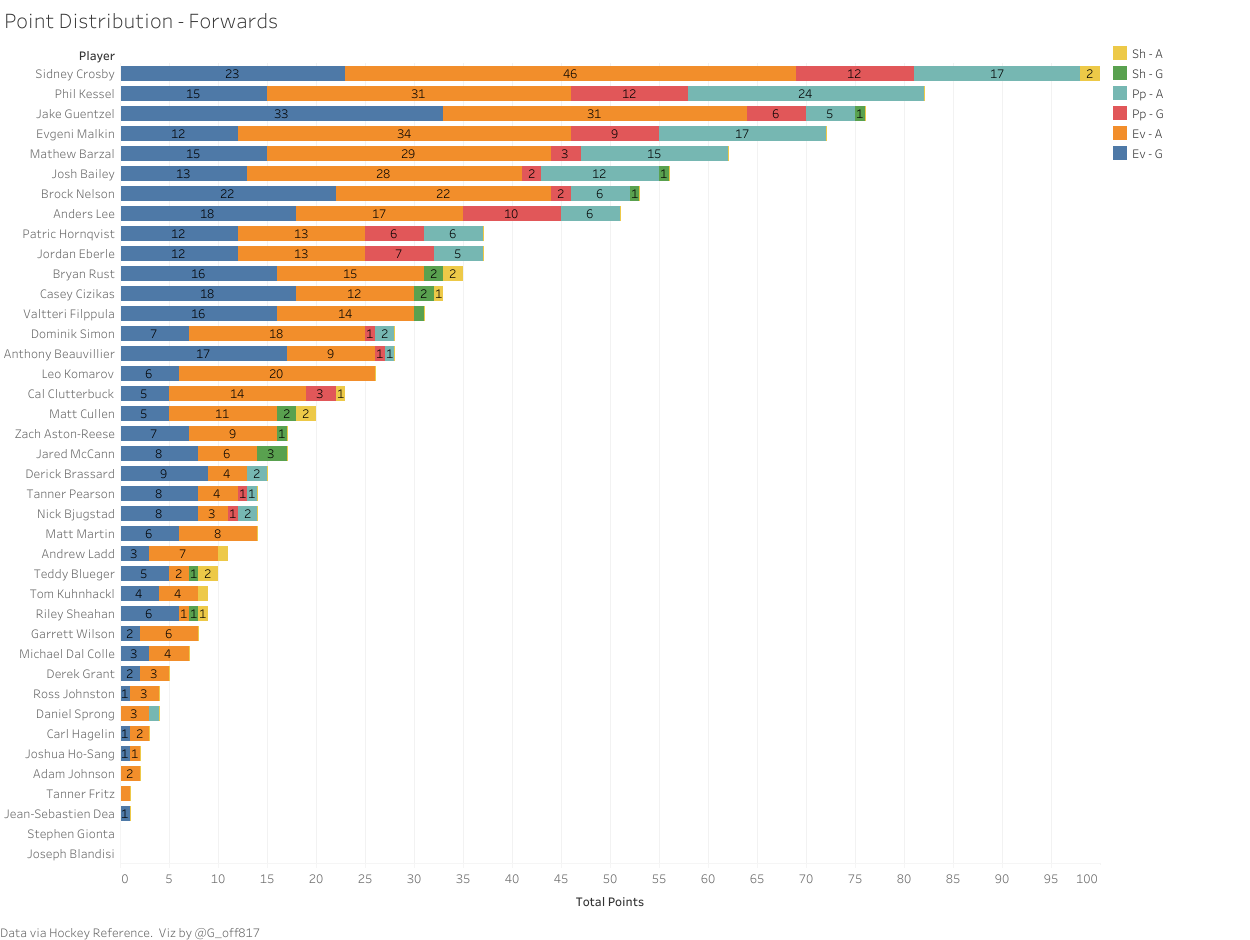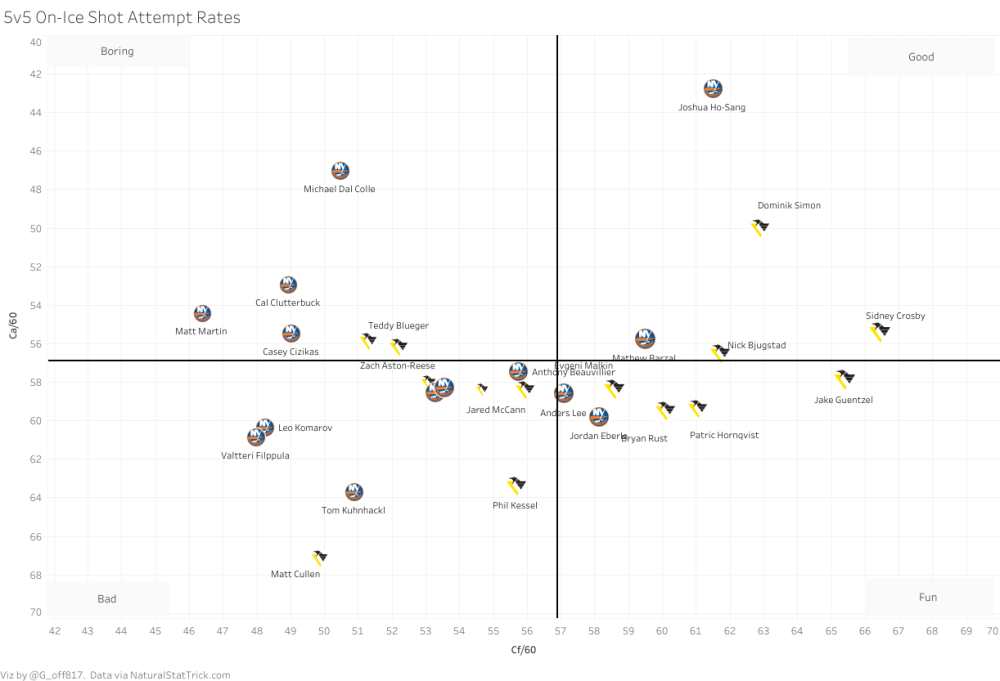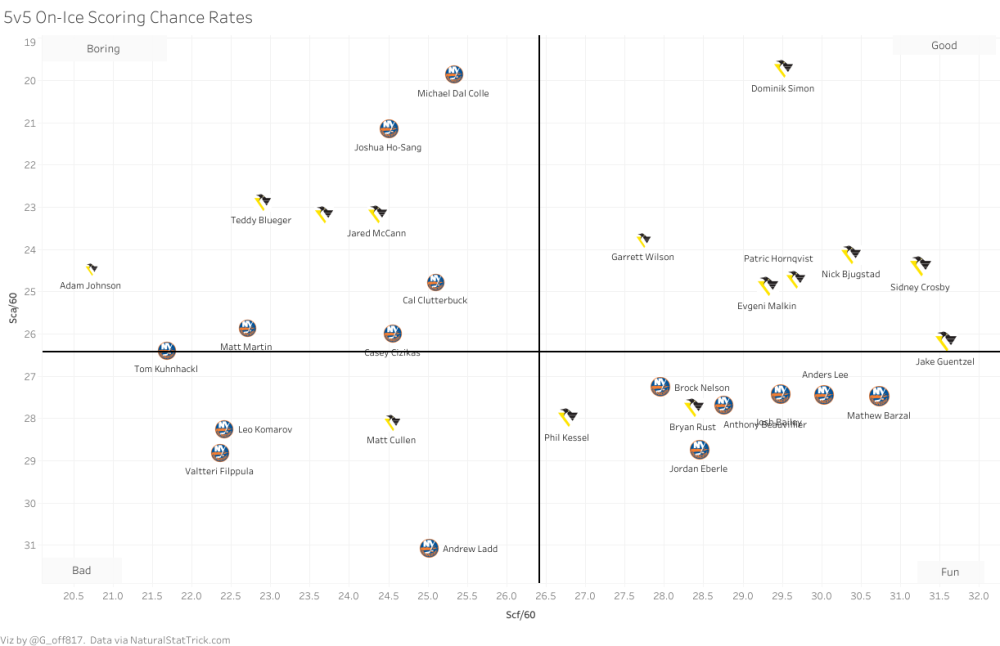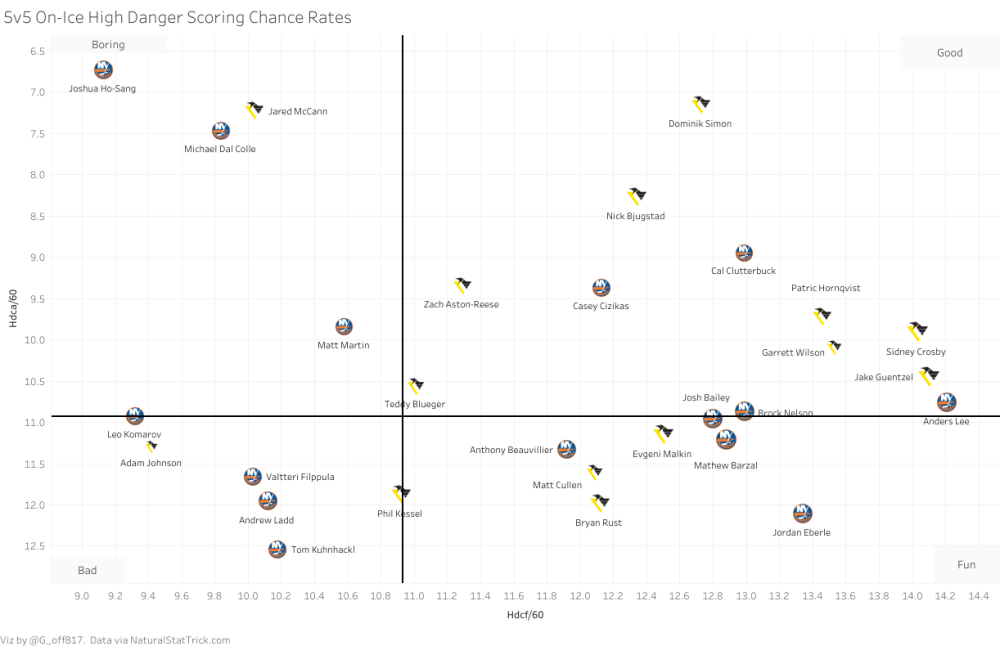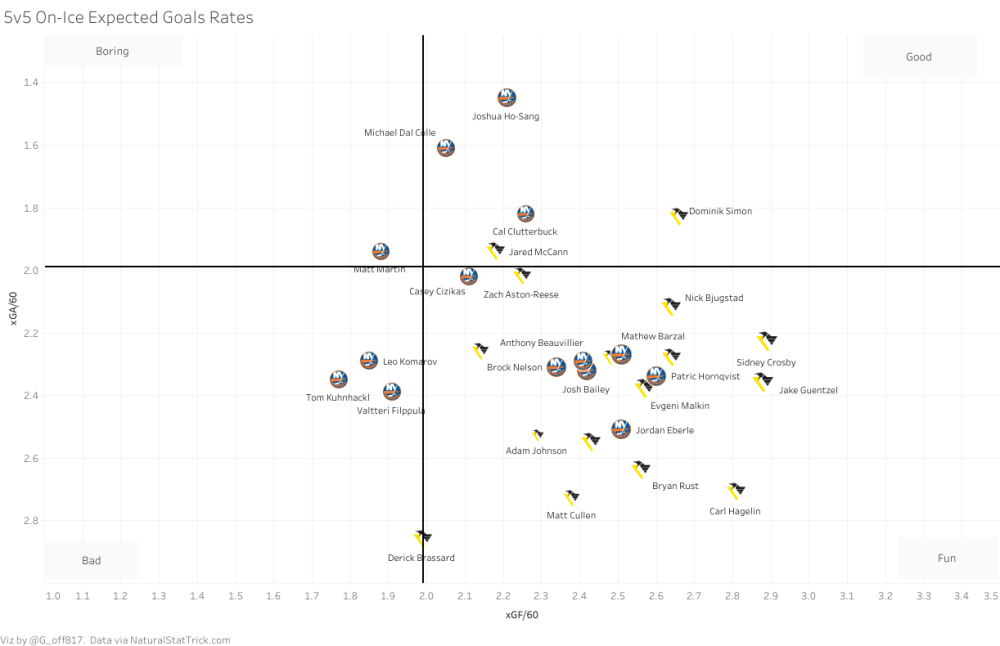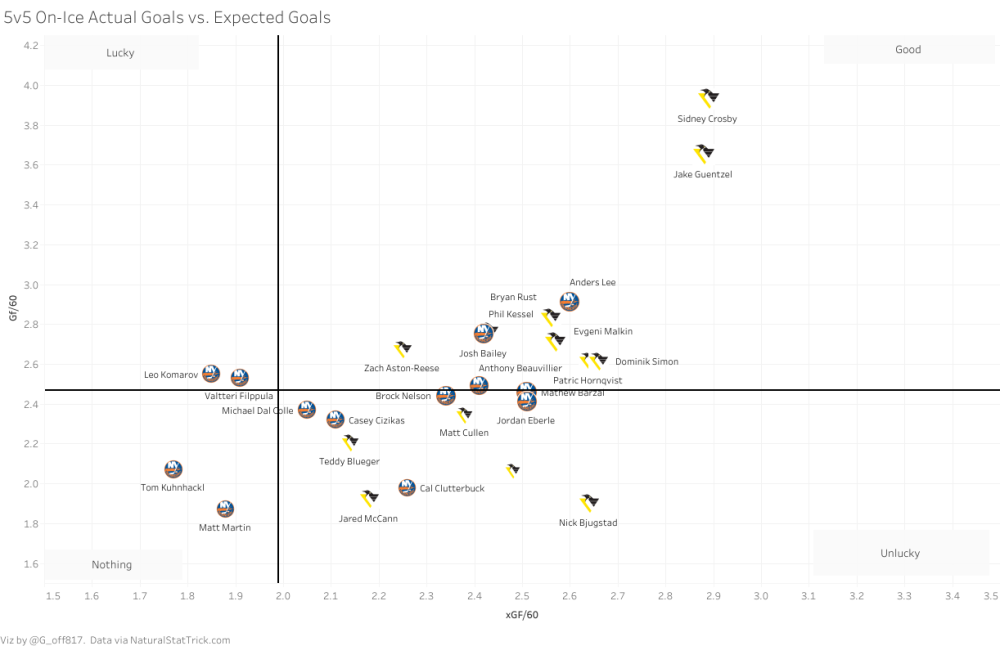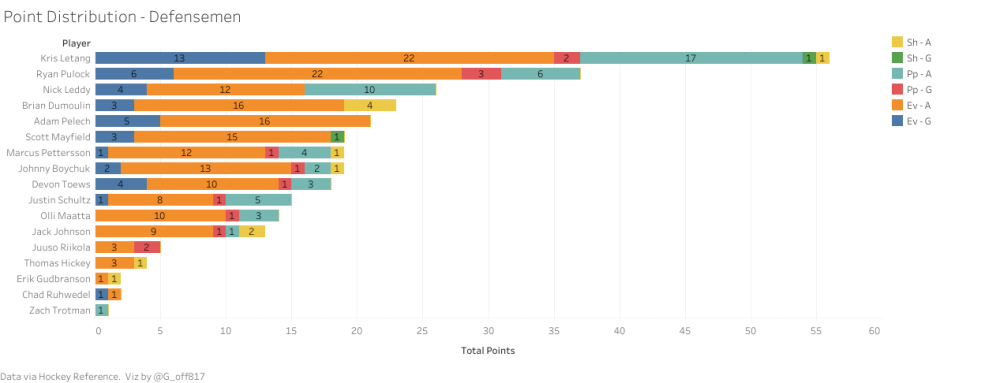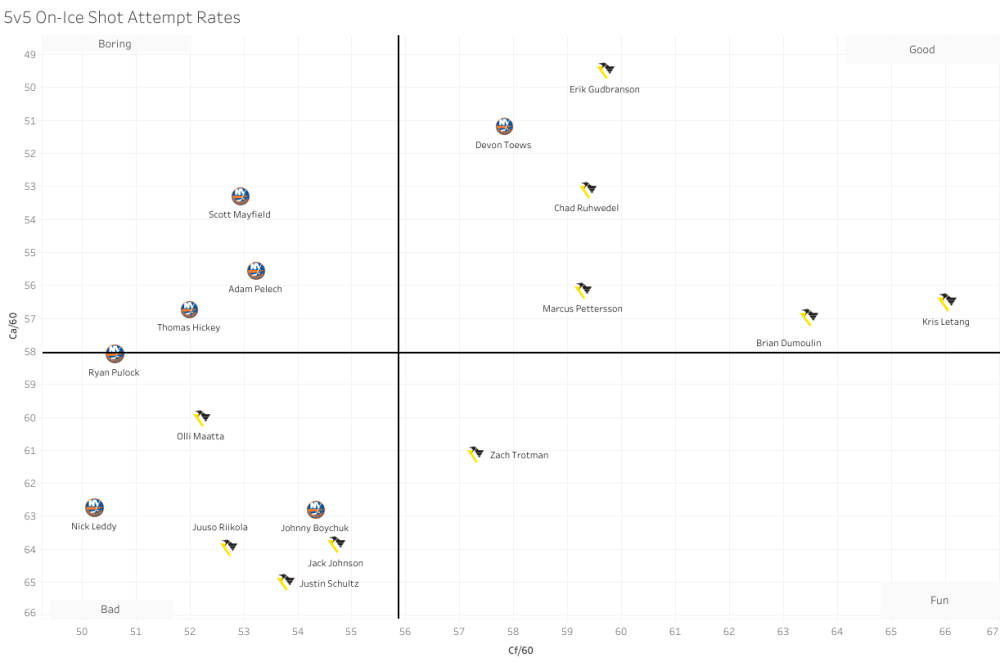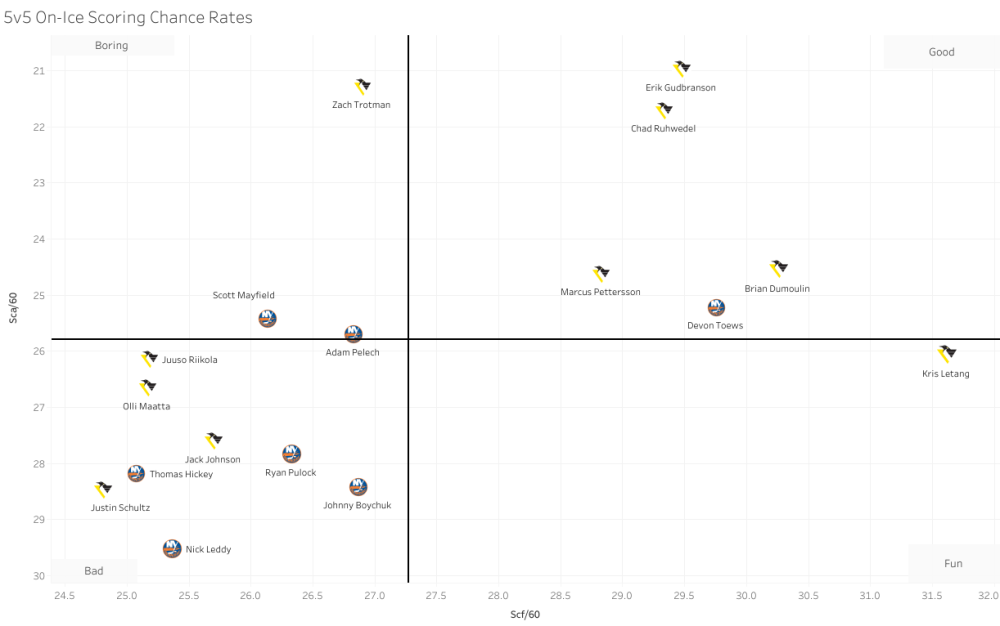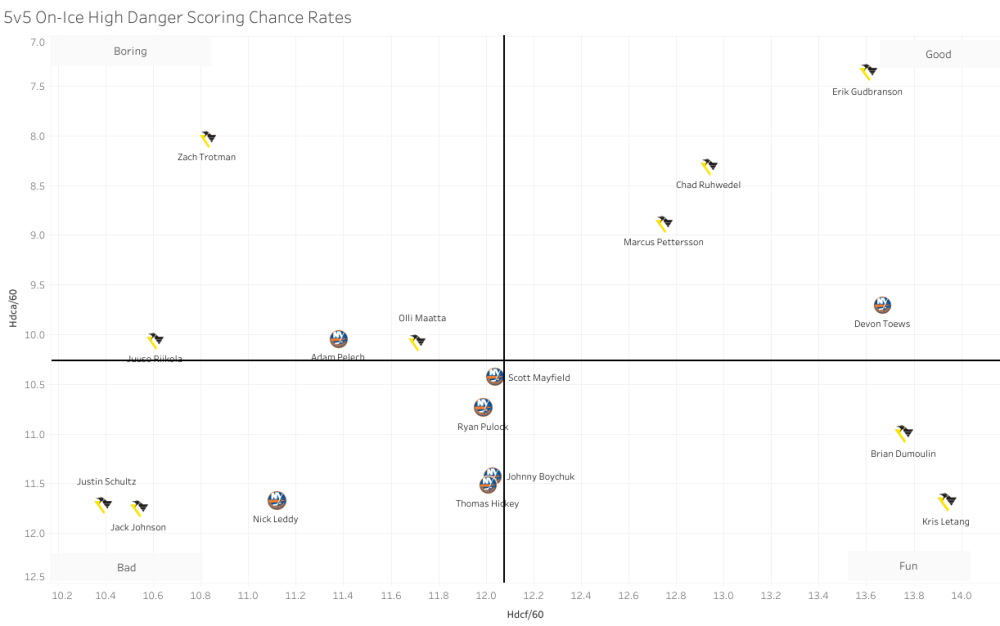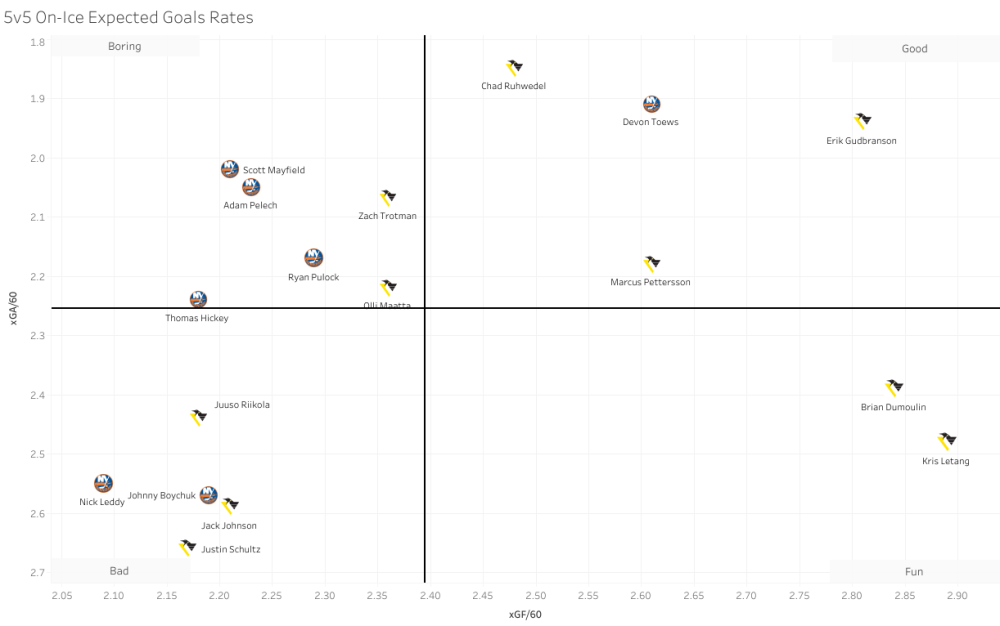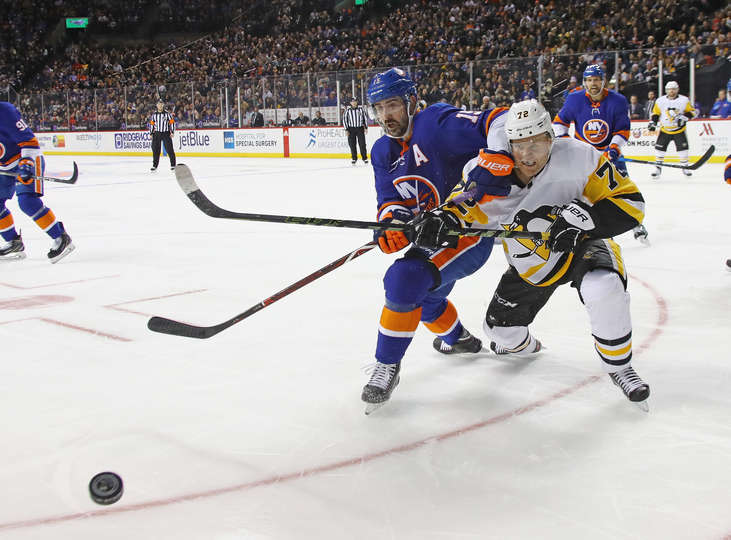
At long last, the NHL playoffs are here. Today, we begin a 3 part series to take a look at the Penguins/Islanders first round matchup. You can read Part 1 here. This is Know Your Enemy Part 2.
Welcome to Part 2 of 3 of the Know Your Enemy series. Today, we look at the skaters involved in this series between the Penguins and Islanders.
As we saw in Part 1, these two teams are very different squads in nearly every way, be it in possession generation, suppression, or goals and points produced
First, let’s look at the forwards.
Note: All data herein courtesy of Natural Stat Trick unless otherwise noted.
Forwards
That idea becomes extremely evident when you take a high level look at the distribution of points between the forwards on both of these squads.
In fact, you have to wait until the 5th highest points producer to finally see a New York Islanders on this list in Mathew Barzal.
Funnily enough, Sidney Crosby ended the season with 65 assists at all strengths, a full 3 more than Barzal had total points (62). That in itself speaks volumes to the Penguins ability to score goals.
Spoiler alert: This won’t be the last time you see Sidney Crosby’s name in a good location of a chart today.
So let’s do just that by first taking a look at who was good, fun, bad, and boring this season in terms of 5-on-5 on-ice shot attempts for and against per 60 minutes of ice time.
A few things stand out here initially. First, why in the holy hell are the Islanders not playing Josh Ho-Sang?
But, more importantly, in terms of shot attempts created and suppressed per hour of 5v5 play, the Penguins have a pretty substantial edge here among their forward group. As we surmised yesterday, the Penguins are certainly more of a high event hockey team than the Isles, which is seen by the sheer quantity of players dispersed from the middle of the chart and, generally speaking, those events are moving in a positive direct for the Penguins than the Islanders.
The Islanders, on the other hand, have a bunch of forwards that are just middle-of-the-road, bordering on bad/boring. That makes sense when you consider the names on their roster and that their lone superstar left standing after the exit of John Tavares is Mathew Barzal. Anders Lee and Josh Bailey are fine players, but they aren’t game changers or even series changers like Tavares, Barzal, Crosby, and Malkin, for instance.
We see this, too, when we consider the rate of on-ice scoring chances and on-ice high danger chances per hour of 5v5 play.
And as we saw in Part 1, there aren’t too many teams that generate more scoring chances and high danger chances than the Penguins, and as you might expect, those rates are led by Sidney Crosby and Jake Guentzel.
What’s encouraging here is that the Penguins top 3 centers firmly cement themselves in the Good quadrant, meaning they are generating a substantial amount of scoring chances while also limiting their opponents from doing the same.
And for a team like the Islanders that don’t create a ton, having to go up against a top 9 of the Penguins that don’t really give up a lot either while living in the offensive zone has to be worrisome for the team from Long Island.
Wrapping all of this up with a pretty bow, let’s mash it all together and take a look at the rates of expected goals (using Natural Stat Trick’s new expected goals model), where we again see just how much quality the Penguins create on a regular basis, something we’ve come to expect from the likes of Crosby, Guentzel, Malkin, and Kessel.
And, for all intents and purposes, the Penguins have finally become a 3, nearly 4 line team again with the addition of Nick Bjugstad and the departure of the very bad Derick Brassard.
The Islanders, as seen above and below, don’t have too much else outside of their top 6.
In fact, when nearly half of your forward group isn’t generating anything in the way of expected goals and isn’t scoring actual goals like the Islanders bottom 6 happens to do, it tells you all you need to know about how top heavy they are.
The Actual Goals vs. Expected Goals below illustrates that, while also illustrating just how lethal Crosby and Guentzel have been this season.
Side note: To the surprise of no one, the one constant here is Dominik Simon in the top right corner of every single possession-based chart and his overall impact in the defensive zone. A matchup that sees his line against the Barzal line could prove to be a big nightmare scenario for Trotz if that’s the direction HCMS tries to go when you consider that the goals are coming from that Barzal line.
Holy cow was Dominik Simon ever good defensively this season. My word. pic.twitter.com/mUJmKBhqgC
— Micah Blake McCurdy (@IneffectiveMath) April 8, 2019
Advantage: Penguins.
Defensemen
So now, let’s move on to the defensemen in this series, where the Penguins largely reign supreme.
First, the distribution of points, where it’s the Kris Letang Show and we’re just tuned for the ratings hog.
Ryan Pulock’s emergence as the guy in New York has been intriguing, supplanting Nick Leddy as the marquee defenseman in that current crop. He’s got an absolute bomb of a shot on the powerplay and his 22 even strength assists was matched only by Letang, who tied his career high this year with 16 goals (in 6 fewer games played).
Letang’s dominance will be captured everywhere as we move along here, just as Jack Johnson’s subservience will be as well.
First, the shot attempts.
One thing that will also stand out is how good Erik Gudbranson has been since being acquired, to the surprise of literally everyone. But just as we saw with the forwards, it’s the top roughly 70% of the roster finding themselves on the right side of the chart.
On the flip side, the low event nature of the Islanders really manifests with their d-men. Guys like Pelech, Mayfield, and Hickey have always sort of struck one as being “get shit done” type of guys where they don’t give you a lot of space to operate, but don’t contribute much going forward.
We see this, too, in the scoring chance data.
Again, the Penguins D run the scoring chance show, led by Kris Letang and Brian Dumoulin. Gudbranson finds himself on the ice for a decent amount of scoring chances for and the fewest amount against per hour of 5v5 play.
As you’d expect, you don’t see the Islanders generating much of their own. In fact, aside from Devon Toews, Adam Pelech, and Scott Mayfield, none of the Isles D find themselves with a positive share of on-ice scoring chances.
And, in terms of the on-ice high danger chances, those same 4 for the Penguins are kings. No one on the Islanders even comes close.
Summarizing this all with the rates of expected goals, we really get to see how run-and-gun Letang is and how good Gudbranson has been compared to the boring nature of Pelech, Mayfield, and Pulock.
One thing that is pretty consistent in the data here is that Nick Leddy, Johnny Boychuk, Justin Schultz, and Jack Johnson find themselves all firmly planted in the Bad realm. Two of those players are not like the other two.
On one team, you have Nick Leddy, whose lowly 26 point season snapped his 3 year streak of 40+ points since moving to the Island. On the other team, you have Justin Schultz. We know what he’s capable of doing.
Quite simply, those pairings aren’t working for either team. Boychuk has found himself in and out of the lineup as a healthy scratch throughout the season, while Jack Johnson played all 82 games. Compounding this struggle is Brian Dumoulin’s imminent return from injury, who will be forcing one of Johnson, Pettersson, Gudbranson, or Maatta out of the lineup.
When asked by Nick Vucic of Pens Labyrinth during a roundtable about what mistakes Sullivan may make, my answer revolved around that:
Continuing to play Jack Johnson. I know this feels like such a cop out to even type out loud, but by every measurable data bucket, he’s far and away the worst defenseman on the team and has had a net negative impact on Justin Schultz since he came back too, just as he has with nearly every player he’s on the ice with.
And when you look at what Olli Maatta has done since coming back from injury and the prospect of Brian Dumoulin coming back for Game 1, you’re looking at a top 4 of Maatta-Letang//Dumoulin-Schultz. Dumo is good with whoever he plays with and HCMS has something working with Maatta-Letang, so it’s hard for me to justify splitting them up. That leaves you with 2 spots for Pettersson, Gudbranson, and Johnson. And with the 19 game body of work that Pettersson-Gudbranson have put together (at 5-on-5, they own a 55.44% share of shot attempts, a 55.69% share of unblocked attempts, 57.20% share on shots on goal, 56.25% share of goals scored, 59.73% share of scoring chances, and 72.41% share of high danger chances when they’re on the ice together) to make Gudbranson, largely regarded as the worst defenseman in the league, coupled with the archaic idea that Gudbranson was brought here to help mitigate the bullshit from guys like Tom Wilson (or, in this series, Matt Martin and Cal Clutterbuck), the odd-man out seems pretty obvious here and it ain’t Erik Gudbranson or Marcus Pettersson.
Never thought I’d see the day where I praised Erik Gudbranson, but aside from his Johnson-level expected goals for and against values, I take Gudbranson over Johnson 8 days a week at this point.
Simply put, when Dumoulin returns, Jack Johnson needs to be the odd man out. At practice yesterday, Dumoulin, a full participant, skated with Zach Trotman while Johnson skated with Letang and Maatta skated with Schultz.
The Penguins came into this series with the better defensive group, but if Jack Johnson is simply a placeholder for Brian Dumoulin, well…
Advantage: Penguins.
Update 4/9/19 – 1:40 PM
D looks different today
Guentzel-Crosby-Rust
McCann-Malkin-Hornqvist
Simon-Bjugstad-Kessel
Blueger-Cullen-Wilson/ZARMaatta-Letang
Johnson-Schultz
Pettersson-Gudbranson
Dumoulin-Trotman— Jonathan Bombulie (@BombulieTrib) April 9, 2019
Still. Advantage Penguins.
The biggest question for the Penguins is how much HCMS tries to match lines.
Intuitively, matching the Simon-Bjugstad-Hornqvist line up against the Lee-Barzal-Eberle line to shut them down seems sensible, if that’s the line he decides to roll with. Either way, Simon’s defensive prowess is unmatched this season. At practice, HCMS worked with:
Guentzel-Crosby-Rust
McCann-Malkin-Hornqvist
Simon-Bjugstad-Kessel
Blueger-Cullen-Wilson/Aston-Reese
Guentzel-Crosby-Rust/McCann, are going to cave in anyone they go up against, but the more Sullivan can get them out against the likes of Leddy and Boychuk, the better chance the Penguins are going to have at owning this series from the start.
And if that’s the case, the goaltending for the Islanders will need to be even better than it was all season long. This is called a teaser for Part 3, where the focus will be on the goalies.
Go Pens.
Add The Sports Daily to your Google News Feed!

